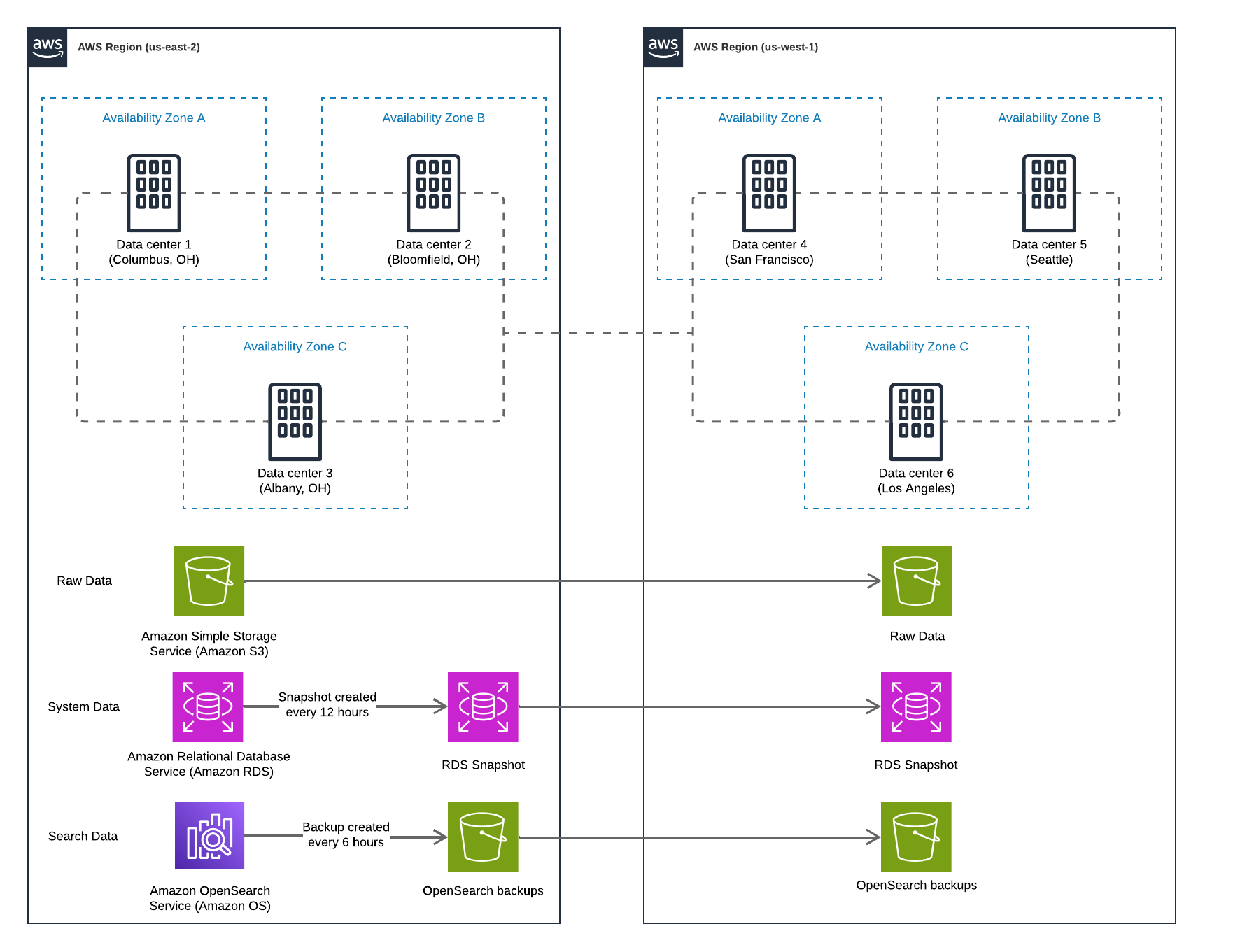TDP Availability and Resilience
Each Tetra Data Platform (TDP) environment runs in a specific AWS Region, but is highly redundant because each Region has multiple, isolated locations known as Availability Zones (AZ). Because of this underlying infrastructure, the platform will continue to operate as normal if a platform component in one AZ goes down, or if an entire AZ fails.
For information about disaster recovery options, see Disaster Recovery.
Built-In Data Availability and Resilience
The following diagram shows how the TDP uses AWS Global Infrastructure to stay highly resilient and available to customers:

For more information, see AWS Global Infrastructure in the AWS documentation.
Availability
The TDP uses AWS services that are designed to be highly available, fault tolerant, and scalable. For example, the following services help ensure high availability for all data in the Tetra Scientific Data and AI Cloud:
- Amazon Simple Storage Service (Amazon S3): Stores files in the Tetra Data Lake. It provides 99.999999999% durability and 99.99% availability of files over a given year by redundantly storing objects on multiple devices across a minimum of three Availability Zones in an AWS Region. An Availability Zone is one or more discrete data centers with redundant power, networking, and connectivity within an AWS Region. For more information, see Data protection in Amazon S3 and Resilience in Amazon S3 in the Amazon S3 User Guide. S3 object backups are made continuously. Data stored in S3 is encrypted at rest.
- Amazon Relational Database Service (Amazon RDS): Provides a scalable, relational database in the cloud that automates time-consuming administration tasks, such as hardware provisioning, database setup, patching, and backups. Amazon RDS provides high availability and automatic failover support for DB instances by using DB deployments across multiple Availability Zones. For more information, see Resilience in Amazon RDS in the Amazon RDS User Guide.
- Amazon OpenSearch Service: Deploys, operates, and scales OpenSearch (an open-source search and analytics engine) clusters in the cloud while providing high availability and automatic failover support across three master nodes and two data nodes deployed across two Availability Zones. For more information, see Resilience in Amazon OpenSearch Service.
- Amazon Elastic Container Service (Amazon ECS): Runs all of the TDP's containerized applications. It provides high availability and automatic failover support for each container by deploying it to two instances across multiple Availability Zones. For more information, see A deep dive into resilience and availability on Amazon Elastic Container Service on the AWS Blog.
For a complete list of AWS services that the TDP uses, see AWS Services.
Resilience
In addition to the high availability and regional redundancy provided by the AWS Global Infrastructure that the Tetra Data Platform (TDP) uses, the TDP also replicates the following services to a second region for disaster recovery purposes:
NOTE
The TDP automatically handles the data backup and synchronization of all services. No user interaction is required for synchronization. For all Tetra hosted TDP deployments, all of the following backups are also copied to the Disaster Recovery (DR) AWS account. If a customer-hosted TDP deployment doesn't have a Disaster Recovery site set up, then all of the following backups are stored in the Amazon S3 bucket of the AWS account where the TDP is deployed.
- Tetra Data Lake: Amazon Simple Storage Service (Amazon S3) buckets are replicated to a separate AWS Region within 15 minutes for disaster recovery purposes. In addition, versioning is enabled for all buckets in the Tetra Data Lake, which means that you can always retrieve and restore every version of each file. For more information, see Why use replication? and Using versioning in S3 buckets in the Amazon S3 User Guide.
- Relational Database: By using Amazon Relational Database Service (Amazon RDS), the TDP creates and saves automated snapshots of each DB instance every 12 hours, which is then retained for 20 days. For more information, see Backup and restore in the Amazon RDS User Guide.
- Search: By using Amazon OpenSearch Service, the TDP creates and saves automated backups of each cluster's search indexes and state to an Amazon S3 bucket every six hours. For more information, see Resilience in Amazon OpenSearch Service in the Amazon OpenSearch Service Developer Guide.
For more information about how the TDP uses AWS services, including how its architecture adheres to the AWS Well-Architected Framework, see TDP Archictecture and Guidance for Integrating the TetraScience Tetra Data Platform on AWS in the AWS Solutions Library.
Updated 6 months ago
